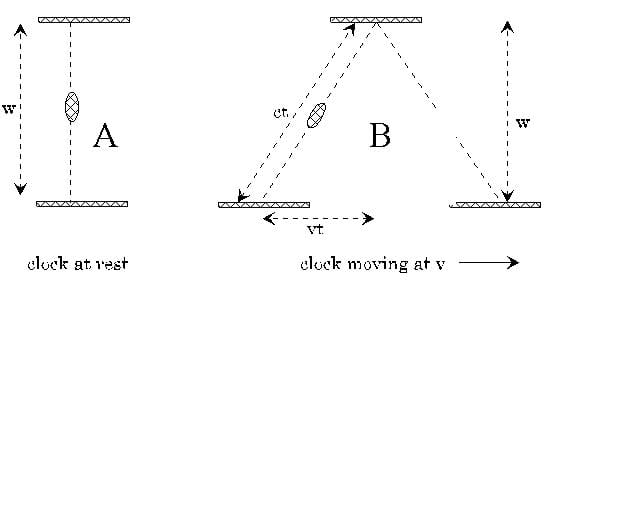Is there a relation between time and space? In our brief for the gravity fields festival we are asked to research into the giants of science. As soon as the question was asked I had a niggling feeling that I have heard it before. Where do space and time connect, and it hit me that I wasn’t thinking in terms of performance anymore, I was thinking in terms of science. Due to the culture that we live in now, we are abashed with new waves of technology, we are constantly trying to make things smaller, using nano technology, we are constantly researching into finding the cure for cancer, and we are constantly asking the question is time travel possible?
When researching into the relation between space and time further I came across a theory that answers that exact question, is time travel possible? The theory I am talking about is from a science giant Einstein, and his theory of Relativity.
Einstein was originally interested in a theory that James Clark Maxwell had predicted. He believed that light travelled at the same speed no matter how you look at it. Brian Cox uses the example of flying towards a spotlight at the speed of light; he says that “If I fly at a spotlight at the speed of light…the light will hit me in the face at the speed of light, not twice the speed of light”(sciencechannel9000, 2012) Einstein was the first person to investigate this theory. Einstein thought of the light clock to explain this.
Brian Cox explains how this works: (Reference lecture) (sciencechannel9000, 2012)
(Fowler, 1996)
This idea of relativity leads to the explanation of how GPS works. Without the use of this equation, Sat Navs would shift by 10km per day. (sciencechannel9000, 2012)
In another lecture, Brian Cox goes on to talk about time dilation. He explains that is a man travels towards a star at the speed of light and comes back to earth; he will be 9 years younger than the people on earth. This is due to the fact that time travels slower the closer to the speed of light that your travel. The perspective of the man in space is that time has travelled the same for him as the person on the earth; it is the perspective of the person on earth that makes it look like this. This even happens at 50mph but in a much smaller way. When someone travels at 50mph the time factor is 1 – (2.78 x 10^-15) at 99.9% of light speed the time factor is 0.0447.If we travelled at the speed of light (which is impossible due to our mass) the view for someone relative to you e.g. on earth whilst you are in space, it would appear that time has stopped and you are still. (The science of Doctor Who, 2013)
How do time and Space link, In order to map the idea of relativity, scientists use a theory known as the space-time continuum. This is defined as, “A four-dimensional reference frame, consisting of three dimensions in space and one dimension in time, used especially in Relativity Theory as a basis for coordinate systems for identifying the location and timing of objects and events. In General Relativity, space-time is thought to be curved by the presence of mass…” (American Heritage, 2002) Imagine a sheet which is held at a height, if a bowling ball is placed on top of the sheet it creates a dip due to the presence of mass.
How does this link to the ideas of performance? During our performance we are exploring the ideas of light and sound, through the use of performance, When we create a performance we are constantly trying to push the boundaries, and by doing so we are trying to break conventions, We often break the convention of time within performance, by creating a performance in symbolic time, we are creating something which is no longer fixed. We are extending the conventions of sound, a minute now no longer symbolises 60 seconds, but instead a minute could be 60 minutes.
The idea of pushing the boundaries of time do not seem that unusual to us, but how do we push the conventions of space. We make the audience believe that we are in a different space to where they actually are, by using descriptive language and props and set to symbolise where we are. But how can we go even further to push our boundaries of time, and is there a way for us to create a correlation between space and time in our performance, can we create a 4 dimensional place where we have three dimensions of space with the added idea of the dimension of time?
When we perform we cannot see Time or space as stable elements, a performances “…space is more than the scenography, the playing area, or the fictional locale to which the set refers. These are instead spaces that are repeated, displaced, condensed, or expanded according to rhythms–time structurations–to help constitute the play’s spatiality.” (Bryant-Bertail, 2004) By this Bryant-Bertail means that space is not just a location that the set portrays; instead it is adapted and changed in conjunction with the rhythm and the way that time is sped up and slowed down. The same happens with time, “Likewise, time is not merely the division of a contained whole into such conventional units as the act, the scene, or the narrative plot line. Rather, it as a unique design of multiple dimensions, durations, and rhythms that gradually and cumulatively reveals itself, a temporality interwoven inextricably into the spatiality at every level of text and performance.” (Bryant-Bertail, 2004) The performance could be explained in a graph, both time and space are connected, there is a correlation, with the changing of speed in the performance the space changes, it becomes extended or displaced altogether, when the space changes time could slow down or speed up.
